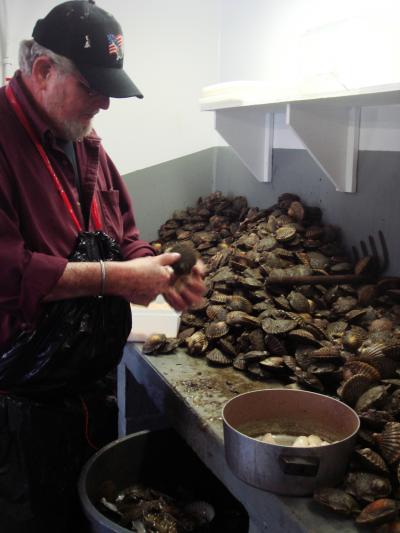Shuckers Will Be Busy This Year

Ahead of the opening of East Hampton Town waters to the harvesting of scallops on Monday, officials of the town’s shellfish hatchery, marine enforcement personnel, the town trustees, and baymen are hoping that a self-policing effort among those harvesting shellfish will bolster official efforts to thwart poaching.
A healthy harvest is in store, said John Dunne, director of the shellfish hatchery, where each year millions of larval scallops, clams, and oysters are spawned and then seeded throughout town waterways to supplement existing shellfish stock. “Napeague, for sure, looks good,” he said of Napeague Harbor, “reminiscent of two years ago. Maybe not quite as robust, but awfully close.” Scallop season opened in state waters this past Monday.
Last November, the 8,000-square-foot scallop sanctuary on the east side of Napeague Harbor, one of two shellfish sanctuaries in East Hampton waterways, was breached, with the buoys delineating its perimeter dragged aside and bottomland uprooted. Mr. Dunne and his staff seed waterways including the sanctuaries at Napeague and Three Mile Harbors, where commercial and recreational fishing is prohibited. “The sanctuaries are looking robust, but that would be expected,” he said. “It’s going be enticing,” he said of the upcoming harvest. He is preparing signs to erect around the sanctuaries. “Everybody seems to know about it. I’m hoping they will police themselves if the enforcement isn’t there.”
In September, Nat Miller, a trustee and 13th-generation bayman, warned his colleagues that the taking of shellfish without a permit or in quantities exceeding that permitted was a problem that was “spiraling out of control.” Fully half of the harvest, he predicted, would be lost through illegal practices, doing significant harm to the local economy.
“I hope people will play by the rules,” Mr. Miller said on Tuesday. “As I said before, you get an attitude of, ‘If everybody’s going to do wrong, I have to do wrong.’ We’ll see how the season goes. Maybe some people will think about it.”
The State Department of Environmental Conservation requires scallops to measure two and a quarter inches and show an annual growth ring. According to the town’s shellfish ordinance, commercial permittees are allowed to harvest five bushels per day. Two or more commercial permittees occupying the same boat while harvesting scallops are allowed up to 10 bushels per day. If only one person in a boat holds a commercial permit, only five bushels per day are permitted. Those with recreational permits are allowed one bushel of scallops per day.
Ed Michels, the town harbormaster, said on Tuesday that a meeting with the trustees and baymen to discuss enforcement had been scheduled but postponed. He said that he has held discussions with town officials regarding an increase in fines for code violations, but no changes would take effect before next year. “If I get to do what I want to, we’ll make those recommendations over the winter and get the code amended,” he said.
Diane McNally, the trustees’ clerk, said that she had discussed enforcement efforts with Mr. Michels after the trustees’ last meeting on Oct. 28. “In this day and age with cellphones, if you see an officer near Accabonac, you can call somebody and say ‘You’re free to do whatever you want in Napeague or Three Mile,’ ” she said. “Ed’s going to talk with his guys.” She said that she had suggested strategies to surprise those potentially poaching in town waters. “I think people going shellfishing are very smart,” she said. “If you want to break the law you can find a way to do it. We just do our best.”
Many praised marine enforcement efforts but decried what they called insufficient manpower. The department, Mr. Michels said, has two full-time and six part-time officers and has documented some 1,300 inspections and issued around 35 summonses related to shellfish this year. “It’s not marine patrol or the quality of the officers, it’s just that there’s not enough of them,” Mr. Miller said. “I notify them occasionally,” Mr. Dunne said. “I see something suspicious, and they’re right on it.”
While the harvest is expected to be a good one, efforts to maintain a healthy environment for shellfish are ongoing. In addition to providing coastal communities with protection from erosion, seagrass improves water quality and offers a safe habitat for shellfish and finfish. “The eelgrass in Lake Montauk is just gone,” Mr. Dunne said. “There used to be a nice bed just off the Gone Fishing Marina. Now it’s just barren.”
The Cornell Cooperative Extension’s Marine Meadows program is one effort to protect and improve eelgrass beds. As part of it, eelgrass shoots are woven into biodegradable discs, which are then planted by divers in waterways including Napeague Harbor. The Save Our Seagrass Celebration, a fund-raiser for the Marine Meadows Program, will be held on Saturday at the South Fork Natural History Museum in Bridgehampton. Details can be found in the Bridgehampton notes this week. Freshly harvested bay scallops will be served.
